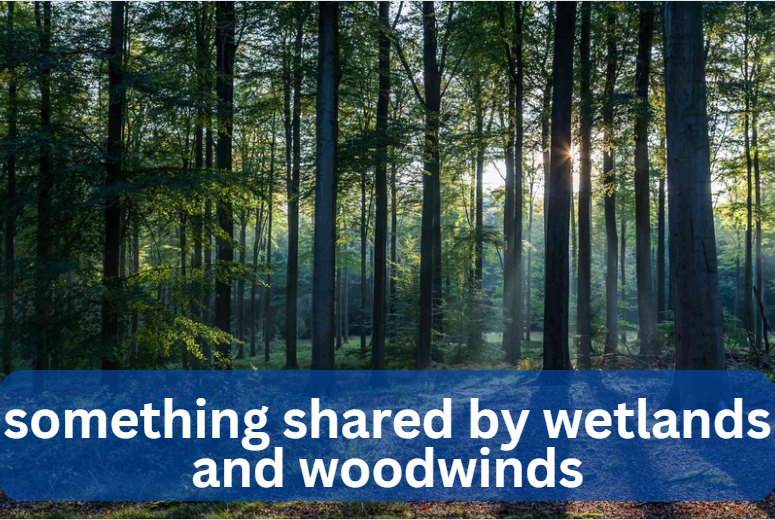
Something Shared by Wetlands and Woodwinds: A Unique Intersection of Nature and Music
Introduction
Something Shared by Wetlands and Woodwinds __ Wetlands and woodwinds—at first glance, these two words might not seem to have much in common. Wetlands refer to natural habitats characterized by waterlogged soils and diverse ecosystems, while woodwinds are a family of musical instruments known for their melodic, airy tones. However, there is a fascinating intersection between these two seemingly disparate subjects that reveals the shared elements of nature and music, highlighting the intrinsic connection between the environment and human creativity. This article explores the intriguing relationship between wetlands and woodwinds, uncovering how both are essential to our understanding of the world around us.
The Natural Beauty of Wetlands
What Are Wetlands?
Something Shared by Wetlands and Woodwinds __ Wetlands are areas where water covers the soil, or is present either at or near the surface of the soil all year or for varying periods of time during the year. These ecosystems include swamps, marshes, and bogs, each with its unique characteristics. Wetlands are among the most productive ecosystems in the world, comparable to rainforests and coral reefs in terms of the biodiversity they support. They provide critical habitats for countless species of plants, animals, and microorganisms, making them essential for ecological balance.
Importance of Wetlands
Wetlands play a vital role in water purification, flood control, carbon sequestration, and shoreline stability. They act as natural filters, trapping pollutants and sediments from surface runoff before they reach open water bodies. Wetlands also serve as natural buffers against storms and floods, absorbing excess water and mitigating the impact of natural disasters. Additionally, they are significant carbon sinks, helping to regulate the global climate by storing carbon that would otherwise be released into the atmosphere.
Threats to Wetlands
Despite their ecological importance, wetlands face numerous threats due to human activities. Urban development, agriculture, and industrial expansion have led to the draining and destruction of many wetlands worldwide. Pollution, invasive species, and climate change further exacerbate these threats, leading to the degradation of these critical ecosystems. The loss of wetlands has severe consequences, including the decline of biodiversity, increased flooding, and the release of stored carbon, contributing to global warming.
The Melodic Art of Woodwinds
Understanding Woodwind Instruments
Woodwind instruments are a group of musical instruments that produce sound when air is blown through a reed or across an opening. They are traditionally made of wood, but modern woodwinds can also be made from metal, plastic, or other materials. The most common woodwind instruments include the flute, clarinet, oboe, bassoon, and saxophone. Each instrument has a distinct timbre, determined by its size, shape, and the material from which it is made.
The Role of Woodwinds in Music
Woodwinds are a crucial component of orchestras, bands, and ensembles, contributing to a wide range of musical genres from classical to jazz. Their versatility allows them to produce a variety of sounds, from the light, airy notes of the flute to the deep, resonant tones of the bassoon. Woodwinds are also known for their expressive qualities, capable of conveying a wide range of emotions through their melodic lines. The ability of woodwinds to blend with other instruments makes them indispensable in creating rich, layered musical compositions.
Crafting Woodwind Instruments
The construction of woodwind instruments is a meticulous process that requires skilled craftsmanship. Traditionally, woodwinds were made from wood such as grenadilla, boxwood, or maple, which were carefully selected for their acoustic properties. The crafting process involves shaping the wood, drilling precise holes, and fitting keys and mechanisms to ensure accurate pitch and tone. Modern advancements have introduced synthetic materials that offer greater durability and consistency, but many musicians still prefer the warm, natural sound of wooden instruments.
The Intersection of Wetlands and Woodwinds
The Connection Between Nature and Music
The relationship between wetlands and woodwinds lies in the deep connection between nature and music. Wetlands, with their diverse ecosystems and rich natural sounds, have inspired countless composers and musicians throughout history. The rustling of reeds, the calls of birds, and the gentle flow of water in wetlands create a symphony of natural sounds that can be likened to the melodies produced by woodwind instruments. This natural music has influenced the creation of compositions that mimic or incorporate the sounds of wetlands, demonstrating the profound impact of nature on the arts.
The Role of Wetlands in Woodwind Craftsmanship
Wetlands play a significant role in the production of woodwind instruments. The wood used in traditional woodwind instruments often comes from trees that thrive in wetland environments. For example, African blackwood (Dalbergia melanoxylon), commonly used to make clarinets and oboes, grows in the moist, swampy regions of Africa. The specific growing conditions of wetland trees contribute to the density and acoustic properties of the wood, making it ideal for crafting high-quality musical instruments.
Cultural Significance of Wetlands and Woodwinds
Both wetlands and woodwinds hold cultural significance in various societies around the world. In many indigenous cultures, wetlands are considered sacred spaces, home to spiritual beings and sources of life-giving water. These cultures often incorporate the sounds of wetlands into their music, using woodwind instruments made from locally sourced materials. For instance, the Australian didgeridoo, traditionally made from eucalyptus wood, is believed to carry the sounds of the land and is used in ceremonies to connect with the natural world.
Similarly, woodwinds have a long history in classical and folk music traditions, where they are often associated with the natural world. Composers like Claude Debussy and Jean Sibelius drew inspiration from nature, creating works that evoke the tranquility and beauty of wetlands. The connection between wetlands and woodwinds is a testament to the enduring relationship between nature and music, where the environment continues to influence and shape human creativity.
Conservation and Preservation
Protecting Wetlands for Future Generations
Given the ecological and cultural importance of wetlands, it is crucial to prioritize their conservation and preservation. Efforts to protect wetlands include the establishment of protected areas, restoration projects, and sustainable land-use practices. International agreements such as the Ramsar Convention on Wetlands aim to promote the conservation and wise use of wetlands through cooperation among nations. Public awareness campaigns and education programs also play a vital role in highlighting the importance of wetlands and encouraging communities to participate in their protection.
Sustainable Practices in Woodwind Instrument Production
The production of woodwind instruments also faces challenges related to sustainability. Overharvesting of trees used in instrument making has led to concerns about deforestation and the depletion of natural resources. To address these issues, instrument makers are increasingly adopting sustainable practices, such as using certified wood from responsibly managed forests and exploring alternative materials. The development of synthetic reeds and bio-based materials offers promising solutions for reducing the environmental impact of woodwind production.
Conclusion
Something Shared by Wetlands and Woodwinds __ Wetlands and woodwinds, though seemingly unrelated, share a deep connection that underscores the relationship between nature and music. Wetlands, with their vibrant ecosystems and natural sounds, inspire the creation of woodwind music, while the materials used in crafting woodwind instruments often originate from wetland environments. Both wetlands and woodwinds are integral to our cultural heritage and ecological well-being, highlighting the need for their preservation and sustainable use. As we continue to explore the intersection of nature and music, it becomes clear that the beauty of wetlands and the melodies of woodwinds are intertwined in ways that enrich our understanding of the world.






